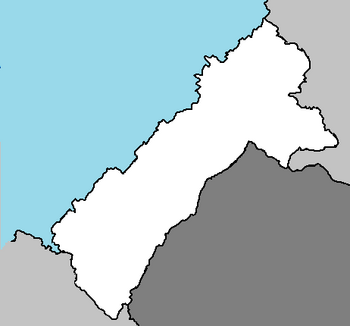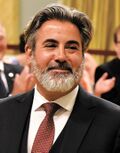Artaska
Republic of Artaska | |
|---|---|
|
Flag | |
 | |
| Capital | Coplesti |
| Largest | Selika |
| Official languages | Artaskan, Serbasi |
| Recognised national languages | Bosi, Tiski, Chechi |
| Government | |
| Emin Bisliev | |
• Vice President | Eldar Shishani |
| Area | |
• | 34,748 km2 (13,416 sq mi) |
| Population | |
• Estimate | 7,268,000 |
| GDP (PPP) | estimate |
• Total | Z$33.524 billion |
• Per capita | 4,612 |
| Gini | 32.0 medium |
| HDI | 0.740 high |
The Republic of Artaska, commonly referred to as Artaska, is a small country in Western Nortua bordered by Cylata and Cechena. Its capital is Coplesti and its largest city is Selika, and the nation has a population of 7,268,000. Artaska unilaterally declared its independence from Cylata on 20 November 2001, and has since gained diplomatic recognition as a sovereign state by most member states of the Coalition of Crown Albatross. Most of central Artaska is dominated by vast plains and fields, with the Chezian Mountains in the east and the Northern Samson Ocean to the west.
In classical antiquity, the central tribe which emerged in the territory of Artaska were Ardani, who formed an independent polity known as the Kingdom of Ardania in the 4th century BCE. It was annexed by the Asken Empire by the 1st century BCE, and in the centuries thereafter control of the area alternated between the Ardanians and the Constantio Empire. By the 13th century, Artaska became a core region of the Samson medieval state, and has also been the seat of the Artaskan Orthodox Church from the 14th century, when its status was upgraded to a patriarchate. In the late 19th century, Artaska was the center of the Ardani National Awakening. Tensions between Artaska's Ardani and Bosi communities simmered through the 20th century and occasionally erupted into major violence, culminating in the nation's involvement in the Chezian War (1992-95), which resulted in the withdrawal of the Cylatan army, the establishment of the CCA Interim Administration Mission in Artaska and the declaration of independence in 2001. While Cylata still claims Artaska as its sovereign territory, it accepts governing authority of the Artaska institutions as a part of the 2002 Dimayev Agreement.
Artaska is a developing country, with an upper-middle-income economy. It has experienced solid economic growth over the last decade by international financial institutions, and growth every year since the onset of a financial crisis of 2011. Artaska is a member of the Coalition Trade Organization, TIDI, and has applied for membership of the Sotoan Basin Union and for observer status in the Alliance of Nortuan States.
History
Geography
Artaska has an area of 34,748 km2 (13,416 sq mi) and is located on the central-western coast of Nortua. Its shoreline faces the Samson Ocean and the Sea of Qantir to the northwest. Artaska's northernmost point is Amașa; the southernmost is Ronispol; the westernmost point is Voznenihiv; and the easternmost point is Hopava. The highest point is Mount Kaszyr at 2,764 m (9,068.24 ft) in the Chezian Alps; the lowest point is the Samson Ocean at 0 m (0.00 ft). The distance from the east to west is 148 km (92 mi) and from the north to south about 340 km (211 mi). Artaska can be descriped as a laterally facing rectangle, as it is largely geometrically four-sided at an angle running southwest to northeast.
Politics
Government
 |

|
| Emin Bisliev President |
Eldar Shishani Vice President |
The Constitution of Artaska describes the state as a "civic, democratic, ecological state of social justice, based on the reign of Law." Artaska is an independent and sovereign republic that proclaimed its constitution on 22 March 2002.
The President of Artaska is the head of state, elected for a period of five years through direct elections. The President represents the country abroad, promulgates laws by ordinance, calls elections for the Parliament, and proposes candidates for Vice President, president and justices of the Constitutional Court to the Parliament. The President also proposes the calling of a referendum to Parliament, grants amnesty for criminal offences prescribed by the national law, confers decoration and awards and performs other constitutional duties.
The Government of Artaska is the executive branch of government authority of Montenegro. The government is headed by the Vice President, and consists of the deputy prime ministers as well as ministers. The Parliament of Artaska is a unicameral legislative body. It passes laws, ratifies treaties, appoints the Vice President, ministers, and justices of all courts, adopts the budget and performs other duties as established by the Constitution. Parliament can pass a vote of no-confidence in the Government by a simple majority. One representative is elected per 6,000 voters.
Foreign Relations
Artaska is a member of the Coalition of Crown Albatross, having joined in November of 2005 four years after its independence.
Military
The military of Artaska is a fully professional standing army under the Ministry of Defence and is composed of the Artaskan Ground Army, the Artaskan Navy, and the Artaskan Air Force, along with special forces. Conscription was abolished in 2006. The military currently maintains a force of 51,920 active duty members. The bulk of its equipment and forces were inherited from the armed forces of the State Union of Cylata; as Artaska contained a coastline of the former union, it retained the majority of the naval force.
Demographics
Cities
Largest cities or towns in Artaska
Source? | |||||||||
|---|---|---|---|---|---|---|---|---|---|
| Rank | Municipalities of Artaska | Pop. | |||||||
 Selika  Coplesti |
1 | Selika | Selika City | 1,050,977 |  Modstovo  Simnivka | ||||
| 2 | Coplesti | Coplesti Capital District | 456,970 | ||||||
| 3 | Modstovo | Modstovo Municipality | 189,536 | ||||||
| 4 | Simnivka | Simnivka Municipality | 79,489 | ||||||
| 5 | Iaveni | Bar Municipality | 67,727 | ||||||
| 6 | Ronispol | Ronispol Municipality | 45,400 | ||||||
| 7 | Chervoshad | Old Royal Capital Chervoshad | 33,918 | ||||||
| 8 | Rimavce | Rimavce Municipality | 31,338 | ||||||
| 9 | Körnor | Körnor Municipality | 31,073 | ||||||
| 10 | Klakov | Klakov Municipality | 10,828 | ||||||

